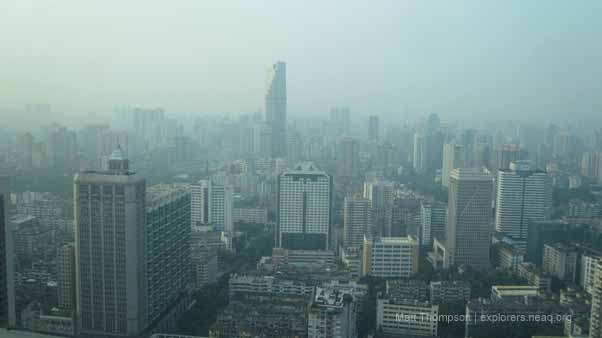
Matt Thompson is a senior aquaculture specialist with the Aquarium’s Sustainable Seafood Programs (SSP). He is blogging from the Seafood Summit in Hong Kong. The Seafood Summit brings all those concerned with sustainable seafood together in a conference to identify challenges and look for solutions.
I awoke in Yangjiang, Dongpin County in the South of China – along with the 8 million people who called this city home. Breakfast in the hotel’s 47th floor revolving restaurant gave us sweeping views of the sprawling city. What surprised me was just how little Chinese influence could be seen in the construction; this really could have been a modern city in the U.S.

Once in the coach again, I started to notice that hidden amongst the overpasses and side roads were very small fish farms – likely no more than 1 or 2 small ponds and family run operations. These are the folks who make up the vast majority of fish farmers globally. Most of their production enters local markets at lower prices, rather than the export market. These operations often lack the financial and technical necessities to meet the requirements of importing countries, meaning that these producers are often scraping by to make a living from their farms. Our goal today was to visit some small-scale marine finfish cage aquaculture in Yangjiang, Dongpin County.

The visual impact of arriving at the site is significant; ahead is what appears to be a small floating town, bobbing in the weak tide just a few hundred feet past the water’s edge. Several boats are lined up with their engines idling, ready to bring us aboard this aquaculture island.

As the boats move through the water, I realized the scale of the industry in the bay. Row after row of small floating cages pass by – over a thousand in all – and each one a simple raft made of a few empty barrels, long planks of wood, and nets that sink a few feet into the water. Below the surface, stocks of pompano, grouper and red drum swim, patiently (or perhaps impatiently) waiting their next meal.

The island is occupied and not just by the visitors eating the freshest of seafood in one of the floating restaurants in amongst the farms. Dogs come barking out of the small huts on the cages; following their master’s command to protect the farm from would be poachers – one of them taking a cooling swim as our boat passes by.

We arrive at one of the farms, guests of the chairman of the Cage Culture Association – a group formed of the farmers of around 400 of the cages in the bay. The Association, a collaborative organization that allows the farmers to pool their resources to buy commercial feed plays an important role in reducing “trash fish”, one of the main environmental issues here.

So called “trash fish” are small wild-caught fish that are unsuitable or unwanted for direct human consumption. The farmer grinds up whole fish to feed the species being farmed. This direct use of fish can be a very inefficient use of marine resources, invites disease, and creates more waste entering the environment. The ability to use commercial feed as a result of Association is an improvement over basic practice. The use of commercial feed is not without its issues, since it is also made with fish as an ingredient, but its a more efficient use than direct feeding. Globally, there is interest in finding alternatives to fish in feed as these resources have become limited, and increasingly more expensive.

We watched as the farm staff harvested some of the fish; a type of pompano. Originally, these fish were stocked as babies (aka fry) from a hatchery in Hainan, a Southern island of China (also known as the Chinese “Hawaii”). They were fed regularly on a dry pellet diet made for “marine fish” – it took around two pounds of feed to produce one pound of the pompano. The fish were harvested by bringing the net to the surface and scooping them out individually – ready for both the domestic fresh or live markets, or as it turns out as gifts for visitors!

While it was clear that some of the farmers in the bay were making improvements to their practices, I felt they still had plenty of work ahead of them from an environmental perspective. That said, the fish looked like they were in really great shape, with clear eyes, bright colors, and good skin condition. They also tasted great!



0 comments:
Post a Comment